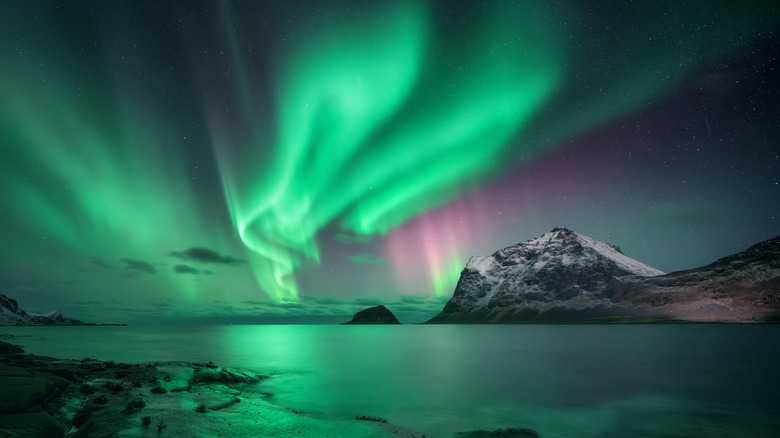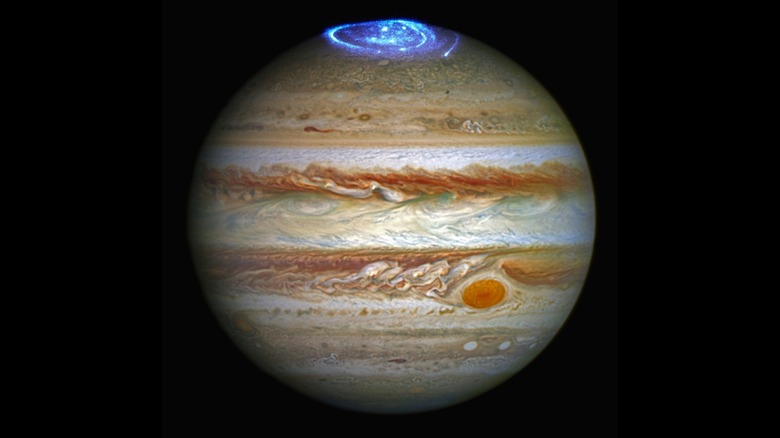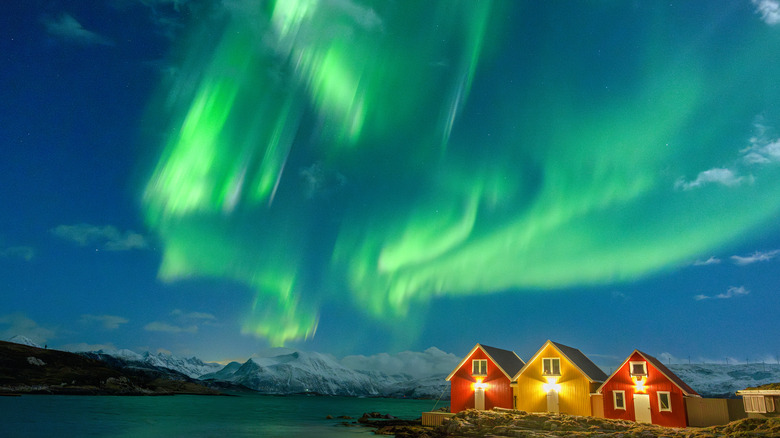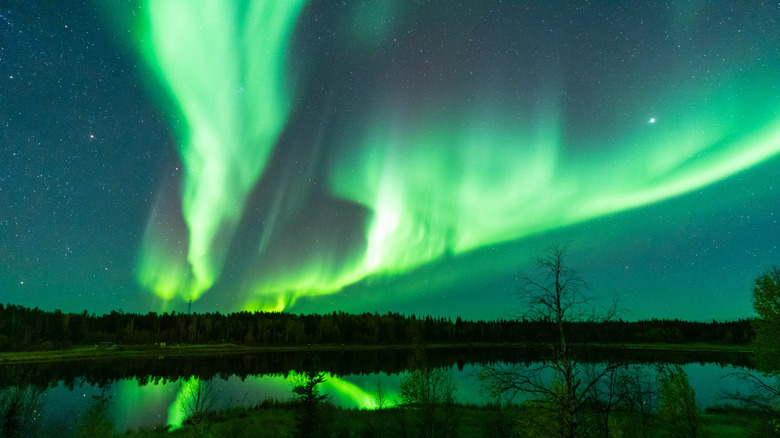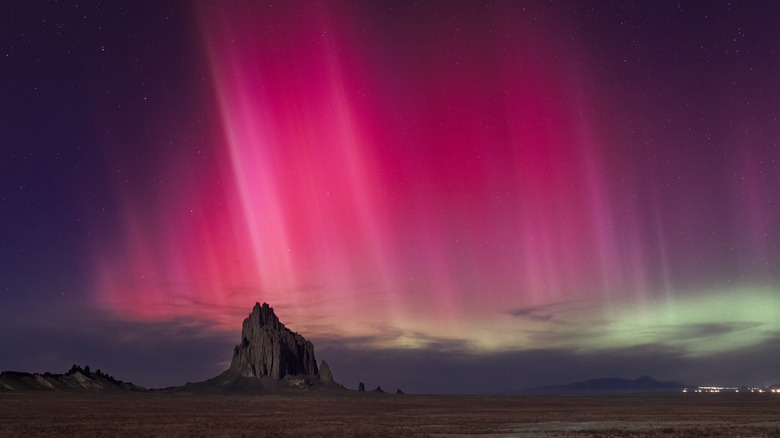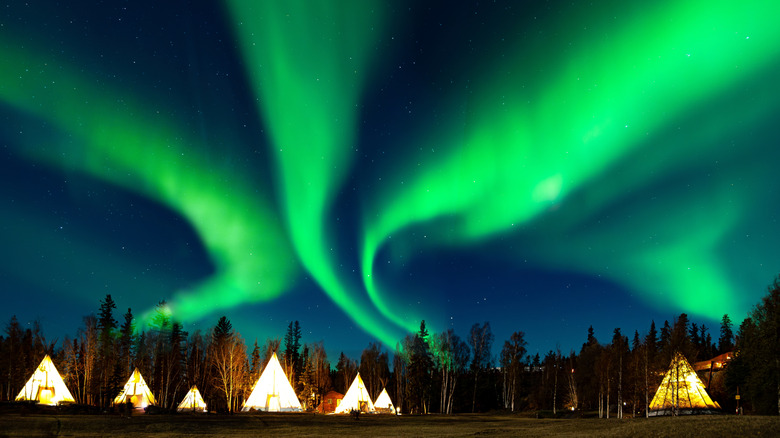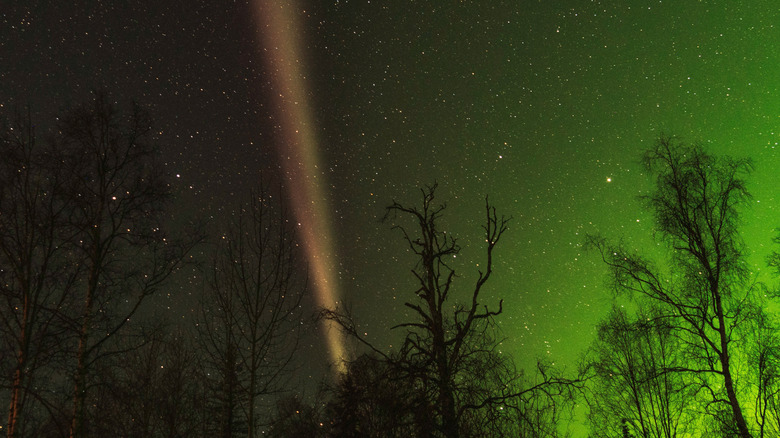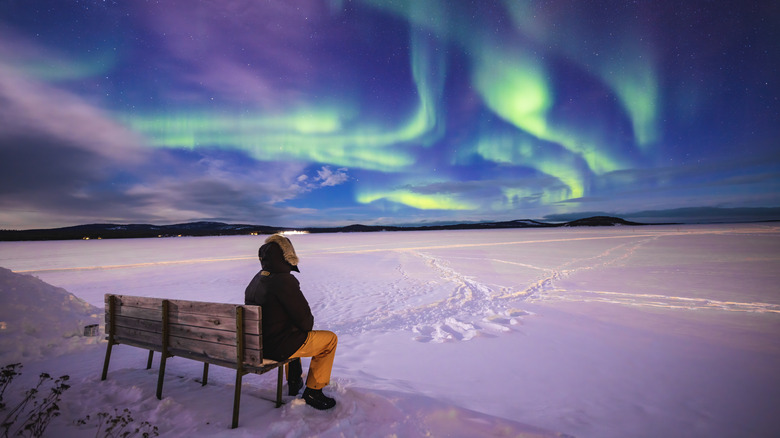How To See The Aurora Borealis (And What The Northern Lights Actually Are)
We may receive a commission on purchases made from links.
If you look up at the sky late at night and see clouds of multicolored light swirling in the darkness, you aren't witnessing an alien invasion; it's just the aurora borealis, aka the northern lights. Despite its ethereal appearance, this high-atmosphere light show is nothing more than particles ejected from the sun slamming into the Earth's magnetic field, gaining energy, and subsequently losing energy. The light you see in the sky during the aurora is the byproduct of this process.
Each instance of the aurora borealis is a swirl of colors such as green, blue, red, and pink. This seemingly unnatural palette lends itself to the northern lights' downright magical spectacle, but again, the colors are nothing more than particles crashing into different atmospheric gases at different altitudes. However, these are only the colors visible to the naked eye; the aurora borealis also produces colors you can't see without hyperspectral imaging hardware. Furthermore, you can't really appreciate just how high up the impacts occur unless you view an image of an active aurora taken from outer space.
No two aurora borealis events are the same, and not just because the colors and patterns differ from aurora to aurora. Depending on when it takes place and the current state of the sun, the northern lights can appear more intense, show off a wider rainbow of colors, and appear in locations that aren't exactly considered "north." We're going to help you find the best times and places to view the aurora borealis.
The aurora borealis is neither new nor unique
Before we get into the details of ideal aurora borealis viewing, we need to clarify something important: The northern lights aren't unique to the Earth's northern hemisphere. The southern lights, aka aurora australis, are virtually identical but appear south of the equator. Heck, auroras aren't even unique to Earth.
Since the northern lights are the colorful result of charged particles hitting the Earth's magnetic field, it stands to reason that any planet with a magnetic field has its own aurora. Astronomers have found evidence of dazzling auroras on Jupiter, and even Mars has enough of a magnetic field to produce its own faint, patchy aurora.
While discovering auroras on other planets is relatively new, humans may have been looking at auroras on Earth for more than 30,000 years. The name "aurora borealis" was coined by Galileo Galilei in the early 17th century, named after the Roman goddess of dawn Aurora and the Greek god of the north wind Boreas. However, the phenomenon entranced audiences even before it had a name. The Vikings, for instance, thought the aurora was light glistening off the armor of valkyries, whereas Inuits believed the aurora was caused by spirits kicking around walrus skulls like a soccer ball. The earliest record of the aurora borealis is believed to be enshrined within a cave painting in France that dates to 30,000 B.C.
Where to see the aurora borealis
As you can probably guess by the name, the northern lights are primarily situated north of the equator. But literally half of the planet is north of the equator. Just how far do you have to go to see the aurora borealis? Pretty dang far.
For the most part, the northern lights only crop in an area known as the "auroral zone." This area stretches 1,553 miles out from the magnetic north pole and encompasses regions in Canada, Alaska, Greenland, Iceland, Finland, Norway, Sweden, and Russia. The aurora borealis sticks to this area because the particles that emit light during auroras are drawn towards the Earth's magnetic poles.
While the northern lights can appear within the auroral zone, it doesn't mean they are visible 24 hours a day, seven days a week. You have to train your eyes north because of the aforementioned magnetic attraction, and like regular stargazing, results are best if you look for auroras on clear, cloudless nights away from cities or anything else that produces light pollution. However, some areas aren't just ideal for viewing the aurora borealis, they're downright famous for it. Locations such as Tromsø, Norway, make for the perfect northern lights getaway, but if you're looking for something closer to the contiguous U.S., you can't go wrong with Yellowknife, Canada. Oh, and you can use forecast services to tell you where and when to look to maximize your chances of catching a peak at the northern lights.
When to see the aurora borealis
Watching the aurora borealis is a lot like watching meteor showers: The conditions have to be just right. Moreover, even though some time periods are optimal for watching the aurora borealis, most of the circumstances that shape the ideal northern lights show are out of your hands.
As we previously established, the darker (and clearer) the sky, the better the aurora borealis show. And believe it or not, some hours of the night are darker than others and therefore ideal for aurora watching. Generally, the northern lights crop up or are at least easier to see within two or three hours of midnight.
Another factor that influences aurora activity is the equinox. During an equinox, the sun is directly above the equator. More importantly, geomagnetic storms flare up, and the more geomagnetically active the sky, the brighter the aurora. As the equinoxes occur around the 20th of each March and September, those months are considered peak aurora borealis season. On a side note, solar flares can produce geomagnetic storms of their own, so whenever astronomers report abnormally large solar flares erupting from the sun, you can generally expect unseasonably bright aurora borealis spectacles. If NASA predicts an increase in solar flares for a certain year — as the organization did back in 2023 for 2025 — take that as your cue to start preparing for an eventful aurora borealis season.
Exceptions to the rules
We just went over the best places and times to watch the aurora borealis. But at the end of the day, the sun determines where and when the charged particles strike, meaning it might provide a fantastical light show for a wider audience.
When the sun starts producing more solar flares and coronal mass ejections, it spews out charged particles in higher densities at higher velocities, which create geomagnetic storms. Since more particles are ejected, the Earth's magnetic field draws more in, which makes auroras brighter and produces light shows at lower latitudes. In 2025, residents in Wyoming had a chance to see the aurora borealis, while a similar geomagnetic storm in 2024 pushed the northern lights to New York and Oregon. When the sun is at its most intense — referred to as "solar maximum" — the northern lights can appear as far south as Texas or even Mexico. This extreme activity only occurs once every 11 years, but the four-to-five years between the solar minimum and solar maximum are widely considered favorable for aurora sightings.
As astronomers are constantly monitoring the sun for solar flares and coronal mass ejections, they have produced a fairly reliable way to predict geomagnetic storms, which in turn has created a reliable aurora borealis predictor. It all revolves around the "Kp index," which measures geomagnetic field activity on a scale of zero to nine. Anything above a six or a seven is considered high and produces not only the brightest auroras but also moves them to lower latitudes.
Take out the guesswork with tours
As mentioned, you can use apps and forecasts to guess where and when the aurora borealis will appear, but some people might prefer to just watch the atmospheric lightshow without putting in much work. Fortunately, there are tour companies that cater to these individuals.
If you want to visit an area known for its aurora borealis spectacle, you can book a guided tour. For instance, you can find plenty just outside of Fairbanks, Alaska, each of which offers hotel stays, complimentary breakfasts, and activities to keep you occupied during the day like a meet and greet with domesticated reindeer. And when night falls, these packages provide transportation to the viewing areas. You'll have to travel for about an hour, but you can do so in a dog sled.
Some northern lights tours are more novel than others. Take the Hurtigruten Astronomy Voyage, for example. Instead of setting you up in a single location, this tour takes place on a cruise ship that ferries guests beyond the Arctic Circle to see the aurora borealis at its brightest. Plus, attendees get to learn more about the night sky thanks to guest lecturers.
Don't confuse aurora with STEVE
When you look up at the sky on a clear night, you can see plenty of stars, but not all of them are stars. Some dots of light are actually satellites — you can usually tell which is which by looking for movement. This case of mistaken identity can fool some viewers, and the same is true when looking at the aurora borealis.
You can easily identify the northern lights by their swirling, multicolor patterns. However, when staring at the clear night sky, you might see a narrow band of color heading from east to west, occasionally accompanied by a green structure colorfully likened to a picket fence. This isn't the aurora borealis but instead a slightly different atmospheric phenomenon known as the Strong Thermal Emission Velocity Enhancement. But you can just call it STEVE.
Despite resembling the northern lights, STEVE is more like a relative of the aurora borealis. The primary color band — which is generally magenta — is the product of superheated particles igniting gases in the atmosphere, producing plasma. The green picket fence portion, meanwhile, is caused by the same process that creates auroras. It is also worth noting that STEVE is rarer than standard aurora borealis, but can pop up further south than the northern lights.
A few friendly pointers
Watching the northern lights is a magical experience. It's easy to see why these high-atmosphere color shows entranced so many early cultures people and inspired their stories. However, there's watching the northern lights, and then there's comfortably watching the northern lights to get the most out of the performance.
As the northern lights are a somewhat random phenomenon, patience is key. You might see the aurora on your first night trying, or you might not, and that's if the sky is clear. If it isn't, you'll have to try again another night. And as previously stated, auroras generally show up anywhere between 9:00 pm and 3:00 am. We also need to emphasize that this late-night viewing often takes place in the coldest reaches of the planet during frigid months. Dressing warmly and in layers is a requirement for virtually any northern lights watch party.
While you can watch the northern lights with the naked eye, many people recommend using a camera, as certain devices (such as smartphone cameras) make spying the aurora even easier. More importantly, cameras let you immortalize the majesty of the northern lights in pictures and video. Most modern cameras will do the job, but professional photographers recommend devices such as the Nikon D5300, Canon EOS Rebel T6, and Nikon Z6. However, any camera with a robust nighttime photography mode and a mirrorless design should work. Consider adding an internal intervalometer if you want to record a time-lapse video instead of a simple snapshot.
